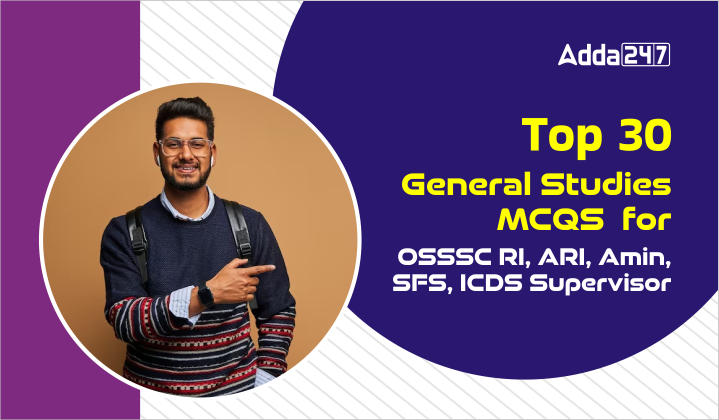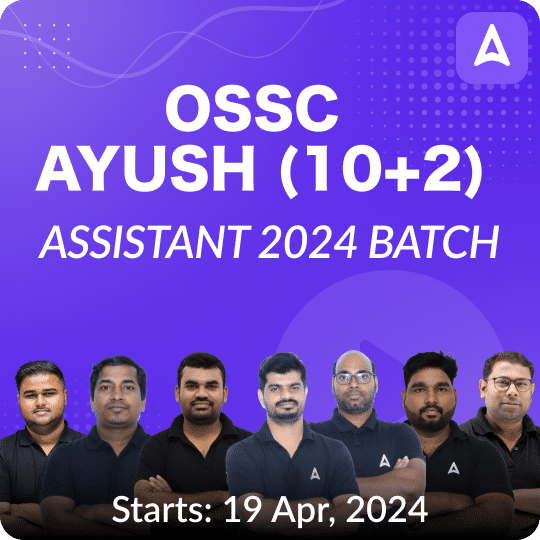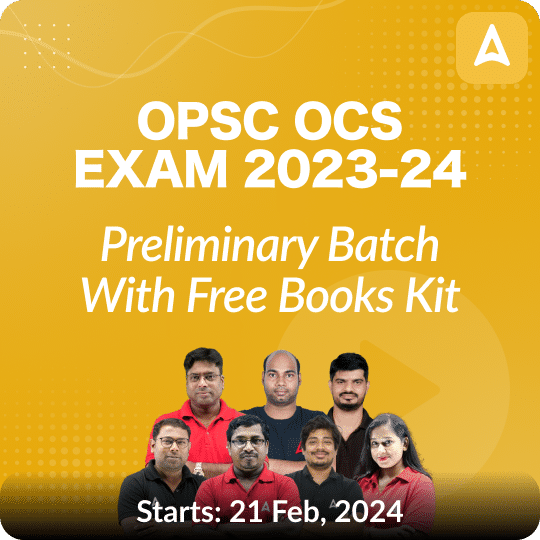General Studies is a crucial component of various competitive exams like OSSSC RI, ARI, Amin, SFS, and ICDS Supervisor. It encompasses a wide range of topics, from current affairs to history, geography, polity, and more. To excel in these exams, it’s essential to have a strong grasp of general knowledge. Here, we present a curated list of the top 30 Multiple Choice Questions (MCQs) that are commonly encountered in these exams, covering diverse subjects to help you prepare effectively.
Top 30 General Studies MCQs For OSSSC RI,ARI, Amin, SFS, ICDS Supervisor
- What is the purpose of a fathometer?
A) Measuring earthquakes
B) Measuring rainfall
C) Measuring ocean depth
D) Measuring sound intensity
Answer: C) Measuring ocean depthExplanation: A fathometer is a depth finder that uses sound waves to determine the depth of water. - What is Epsom, England, associated with?
A) Snooker
B) Shooting
C) Polo
D) Horse racingAnswer: D) Horse racingExplanation: Epsom is a town in Surrey, England, known for Epsom Downs Racecourse, - where The Derby horse race is held.
Who was the fastest shorthand writer?
A) Dr. G. D. Bist
B) J.R.D. Tata
C) J.M. Tagore
D) Khudada Khan
Answer: A) Dr. G. D. BistExplanation: Dr. G. D. Bist, a Guinness Record Holder, achieved a speed of 250 w.p.m. in shorthand. - Which country does golf player Vijay Singh belong to?
A) USA
B) Fiji
C) India
D) UK
Answer: B) FijiExplanation: Vijay Singh, known as “The Big Fijian,” is an Indo-Fijian golfer born in Fiji. - “One People, One State, One leader” was the policy of
A) Stalin
B) Hitler
C) Lenin
D) Mussolini
Answer: B) HitlerExplanation: This policy was associated with Hitler’s regime in Germany. - What is the full form of IG in the police department?
Answer: IG stands for Inspector General of Police. - What does DRDL stand for?
A) Defence Research and Development Laboratory
B) Department of Research and Development Laboratory
C) Differential Research and Documentation Laboratory
D) None of the above
Answer: A) Defence Research and Development Laboratory - Why does exposure to sunlight help improve health?
A) The infrared light kills bacteria in the body
B) Resistance power increases
C) The pigment cells in the skin get stimulated and produce a healthy tan
D) The ultraviolet rays convert skin oil into Vitamin D
Answer: D) The ultraviolet rays convert skin oil into Vitamin D - Where is the headquarters of the registered voluntary association “Transparency International” located?
(a) Helsinki, Finland
(b) Geneva, Switzerland
(c) Berlin, Germany
(d) Paris, France
Ans: (c) Berlin, Germany - Who appoints the Secretary-General of the United Nations Organization?
(a) General Assembly
(b) Security Council
(c) Trusteeship Council
(d) World Bank
Ans: (a) General Assembly - Which countries does the International Criminal Court lack jurisdiction over?
(a) France, China, Pakistan, Afghanistan
(b) UK, France, China, Pakistan
(c) USA, UK, Russia, France
(d) USA, Russia, China, Israel
Ans: (d) USA, Russia, China, Israel - Seasonal variation in Earth’s weather condition is the effect of _____ of the Earth?
(a) Diastrophism
(b) Erosion
(c) Revolution
(d) Rotation
Ans: (c) Revolution - Which planet of the Solar system experiences Sunrise on the West?
(a) Jupiter
(b) Venus
(c) Mercury
(d) Mars
Ans: (b) Venus - What is the difference between a Nuclear reactor and an atomic bomb?
(a) No chain reaction takes place in the atomic bomb while it takes place in a nuclear reactor
(b) The chain reaction in a nuclear reactor is not controlled
(c) The chain reaction in a nuclear reactor is controlled
(d) No chain reaction takes place in a nuclear reactor while in the atomic bomb there is a chain reaction
Ans: (c) The chain reaction in a nuclear reactor is controlled - Which of the following is used for indigestion?
(a) Baking Soda
(b) Milk of Magnesia
(c) Quick lime (calcium oxide)
(d) All of the above
Ans: (d) All of the above - What is the process of drilling small-sized holes deep into the Earth’s surface for injecting water, sand, and chemicals in order to obtain shale gas and oil reserves known as?
(a) Fracking
(b) Chroning
(c) Dreecking
(d) Pulverising
Ans: (a) Fracking - In superconductivity, the conductivity of a material becomes_______
(a) Infinite
(b) Finite
(c) Zero
(d) None of the above
Ans: (a) Infinite - What is the general pitch of the voice of women?
(a) The same as that of men
(b) Much lower than that of men
(c) Higher than that of men
(d) Marginally lower than that of men
Ans: (c) Higher than that of men - What is responsible for the diffusion of light in the atmosphere?
(a) Water vapors
(b) Helium
(c) Dust particles
(d) Carbon Dioxide
Ans: (c) Dust particles - What source provides some heat to the atmosphere even after sunset?
(a) Albedo effect
(b) Latent heat
(c) Invisible solar radiation
(d) Terrestrial radiation
Ans: (d) Terrestrial radiation - The permanent hardness of water is primarily due to the presence of _______.
(a) Bicarbonates of magnesium and calcium
(b) Carbonates of sodium and magnesium
(c) Sulphates of magnesium and calcium
(d) Sulphates of sodium and potassium
Ans: (c) Sulphates of magnesium and calcium - Among the following planets, which one does not orbit the Sun from west to east?
(a) Venus
(b) Jupiter
(c) Mars
(d) Mercury
Ans: (a) Venus - Which planet(s) does not have a natural satellite?
(a) Mercury
(b) Venus
(c) Both (a) and (b)
(d) Saturn
Ans: (c) Both (a) and (b) - Which continent is known as a hollow continent due to its low population in the central areas?
(a) Europe
(b) South America
(c) Australia
(d) Africa
Ans: (b) South America - The Murray-Darling system, one of the greatest rivers in the world, is located in which country?
(a) Germany
(b) Australia
(c) Russia
(d) Canada
Ans: (b) Australia - Polar Stratospheric Clouds are associated with which environmental phenomenon?
(a) Artificial Rain
(b) Acid Rain
(c) Greenhouse effect
(d) Ozone layer depletion
Ans: (d) Ozone layer depletion - Which type of Laser is commonly used in Laser Printers?
(a) Gas Laser
(b) Dye Laser
(c) Excimer Laser
(d) Semiconductor Laser
Ans: (d) Semiconductor Laser - The ozone layer prevents the entry of which types of rays into the atmosphere?
(a) UV-A only
(b) UV-B only
(c) UV-C only
(d) Both UV-B and UV-C
Ans: (d) Both UV-B and UV-C - What happens to the value of ‘g’ as we move from the equator to the poles?
(a) Remains the same
(b) Increases
(c) Decreases
(d) None of these
Ans: (c) Decreases - Which of the following is not considered a structural reform in India?
(a) Reduction of interest rates
(b) Land reforms
(c) Tax reforms
(d) Delicensing
Ans: (c) Tax reforms
















